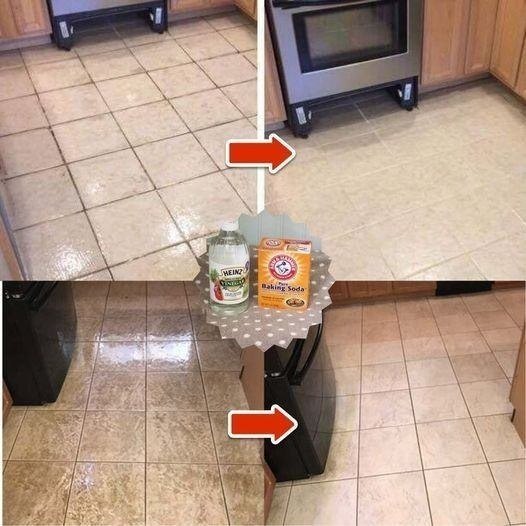ADVERTISEMENT
- Create a baking soda paste: Mix a small amount of baking soda with water to create a paste. Apply this paste directly to stained areas on the tile or grout.
- Spray vinegar: Pour or spray white vinegar over the baking soda paste. The fizzing action will help break down dirt and grime.
- Scrub the grout: Use a toothbrush or grout brush to scrub the grout lines. The paste will work to lift dirt, mildew, or discoloration. For tiles, gently scrub the surface with a soft sponge or cloth to remove stains.
- For Complete Cooking STEPS Please Head On Over To Next Page Or Open button (>) and don’t forget to SHARE with your Facebook friends
- Rinse and dry: Once the stains are gone, rinse the tiles thoroughly with clean water to remove any residue from the baking soda and vinegar mixture. Dry the surface with a soft cloth.
4. Restoring Shine to Dull Tiles
If your tiles have lost their shine, restoring their luster is possible with a few easy steps. Here’s how you can give your tiles that glossy, fresh-from-the-showroom look.
What You’ll Need:
- Glass cleaner (for glossy tiles)
- Microfiber cloth or soft towel
- Ammonia (for deep cleaning, optional)
Steps:
- Clean the tiles first: Make sure the tiles are completely clean and dry before attempting to shine them. Any dust, dirt, or residue will dull the shine.
- Use glass cleaner: For glossy tiles (like porcelain or ceramic), spray a glass cleaner directly onto the tiles. Glass cleaner is great for giving tiles that extra shine, especially on glossy or shiny finishes.
- For Complete Cooking STEPS Please Head On Over To Next Page Or Open button (>) and don’t forget to SHARE with your Facebook friends
- Buff with a microfiber cloth: Using a clean microfiber cloth, buff the tiles gently in circular motions. This will polish the surface and restore its natural shine.
- Use a mild ammonia solution (optional): For heavily soiled or deeply stained tiles, you can use a diluted ammonia solution (about 1/4 cup of ammonia in 1 gallon of water). Mop or wipe the tiles with this solution, and then rinse with clean water. Make sure to ventilate the area well when using ammonia, and always wear gloves.
- Dry thoroughly: After cleaning and shining, always dry your tiles thoroughly to avoid water spots or streaks. Use a soft microfiber cloth or towel to buff the tiles.
5. Tips for Maintaining Tile Shine
Now that your tiles are clean and shiny, it’s important to maintain their shine and cleanliness. Here are some quick tips to keep them looking great:
- Clean spills promptly: Wipe up spills, especially those from acidic substances like vinegar or lemon juice, immediately to prevent staining or discoloration.
- Use doormats: Place doormats near entrances to prevent dirt and grime from being tracked onto your tiles.
- Regular dusting and sweeping: Sweep or vacuum your floors regularly to prevent dirt buildup. This is especially important for high-traffic areas like kitchens and bathrooms.
- Avoid harsh chemicals: When cleaning tiles, avoid using harsh chemicals or abrasive scrubbers that can damage the surface. Stick to pH-neutral cleaners and soft sponges or cloths.
- Seal grout lines: To prevent staining and dirt buildup in grout lines, consider sealing them with a grout sealer. This will make the grout more resistant to dirt and stains.
Conclusion
With the right tools, ingredients, and techniques, cleaning and shining tiles is a straightforward task. Whether you’re working with ceramic, porcelain, or stone tiles, a regular cleaning routine can keep your surfaces looking fresh and sparkling. For everyday cleaning, mild dish soap and water work wonders, while a deeper clean may require a baking soda paste or vinegar solution to tackle tough stains and grout lines. By following these steps and tips, you can restore the shine to your tiles and enjoy a gleaming, spotless surface for years to come.
Remember, consistency is key. A little regular maintenance goes a long way in keeping your tiles looking as good as new!
